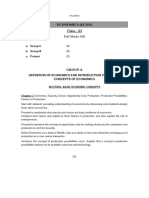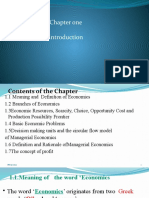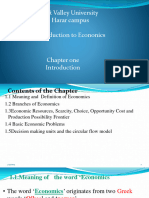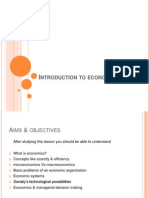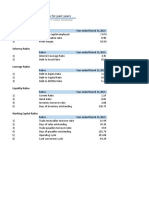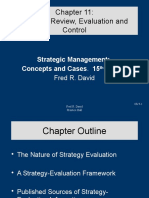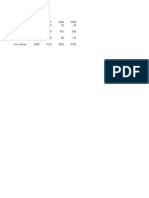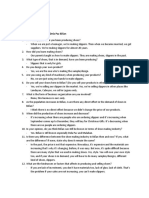Introduction to Economic
Problems:
ey Points:
K
1. Resources are scarce, but human wants are
unlimited.
2. Scarcity leads to the need for efficient resource
allocation.
3. Every economy faces three central problems:
WHAT TO PRODUCE?
HOW TO PRODUCE?
FOR WHOM TO PRODUCE?
Problem 1 - What to Produce?
Explanation:
Resources available to an economy are scarce. An
economy cannot produce all that the society needs.
This compels the economy to utilise its scarce means so
that society gets maximum aggregate Satisfaction.
Indian Economy Context:
Agriculture vs. industrial development: Prioritizing food
grain production alongside manufacturing.
Focus on green energy vs. traditional coal-based
energy.
Example: From a given quantity of land, either wheat or
cotton can be produced or a combination of them. If it is
desired to produce more wheat and less cotton, land
use will have to get diverted from cultivation of cotton to
wheat.
Problem 2 - How to Produce?
� xplanation:
E
Goods can be produced in more than one way.
Production techniques may be either labour-intensive or
capital-intensive.
An economy will opt for the technique which uses the
least amount of scarce resources for a given quantity of
output.
Indian Economy Context:
Labor-intensive methods are encouraged in rural areas
to generate employment (e.g., MGNREGA).
High-tech methods used in urban sectors for industries
like IT and manufacturing.
Example: A given amount of foodgrains can be
produced either by using more capital and less labour or
less capital and more labour. We have to make a choice.
Problem 3 - For Whom to Produce?
Explaination:
• Problem of "for whom to produce" means how the
national product i.e. national income is to be distributed
among the factors of production that helped to produce
it.
It is the factor prices namely rent, wages, interest and
profits which determine the distribution of goods among
the various individuals in the society.
Indian Economy Context:
• Welfare schemes like Public Distribution System (PDS)
ensure food security for the poor.
Increasing focus on bridging rural-urban divides in
healthcare and education.
� xample: How should production be distributed among
E
landlords, labourers, capitalists and entrepreneurs who
are the suppliers of factor services.
Additional Challenges in the Indian Context
Key Points:
• Unemployment: Large population with limited job
opportunities.
• Inflation: Rising prices affect affordability of essential
goods.
Environmental Concerns: Balancing economic growth
with sustainability.
Examples:
• High unemployment during the COVID-19 pandemic.
Rising cost of onions and tomatoes in 2023.
Government Initiatives to Address These Problems
Key Policies:
• What to Produce: "Make in India" to boost
manufacturing and reduce imports.
• How to Produce: Skill India Mission to equip workers
for modern industries.
• For Whom to Produce: Direct Benefit Transfer (DBT)
for targeted subsidies.
Conclusion:
Summary:
The central problems of an economy are interconnected
and require continuous evaluation.
In India, policy decisions aim to address these issues
while fostering inclusive growth.
� alancing economic efficiency, equity, and sustainability
B
is critical for long-term success.

